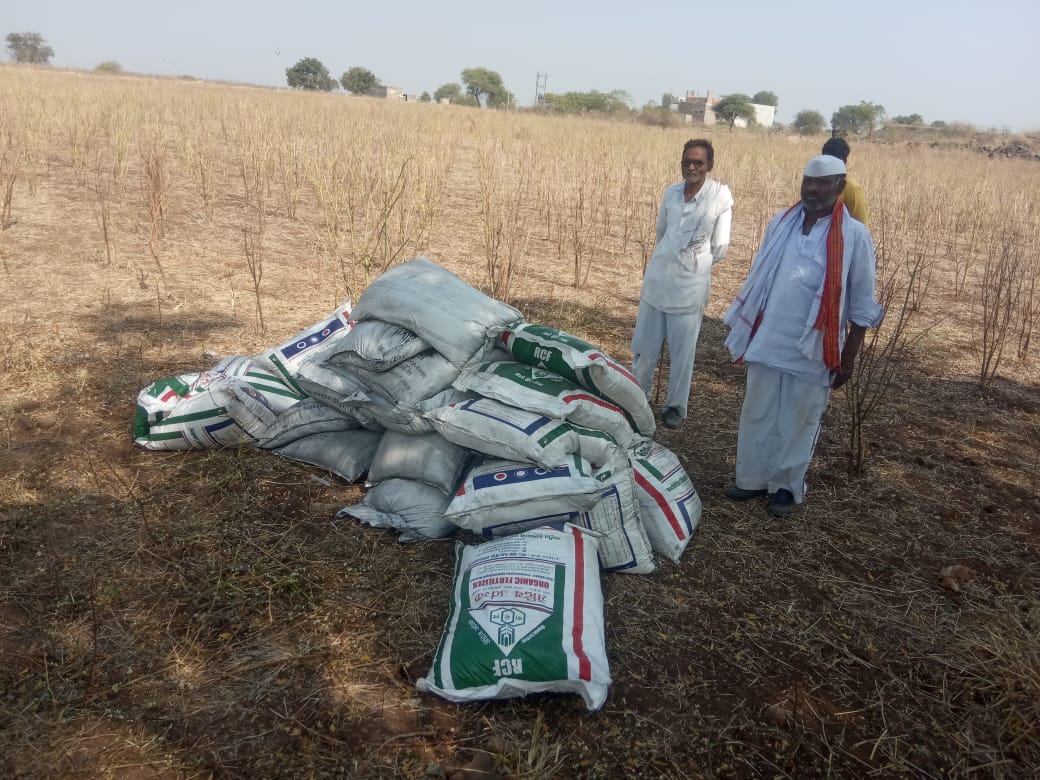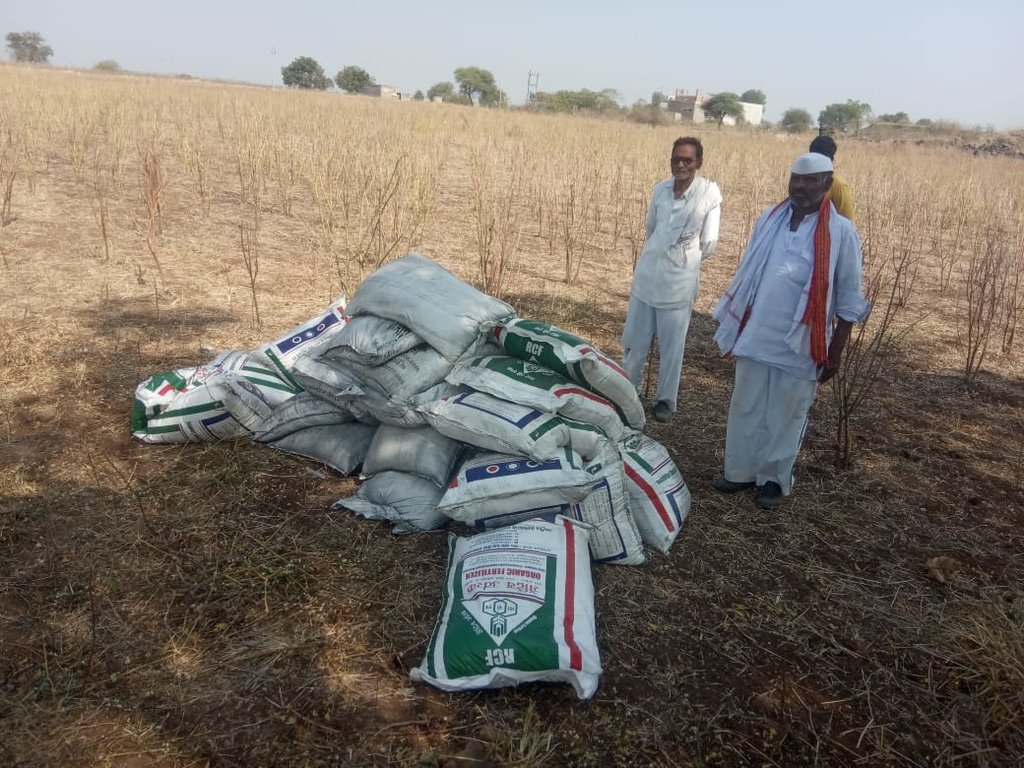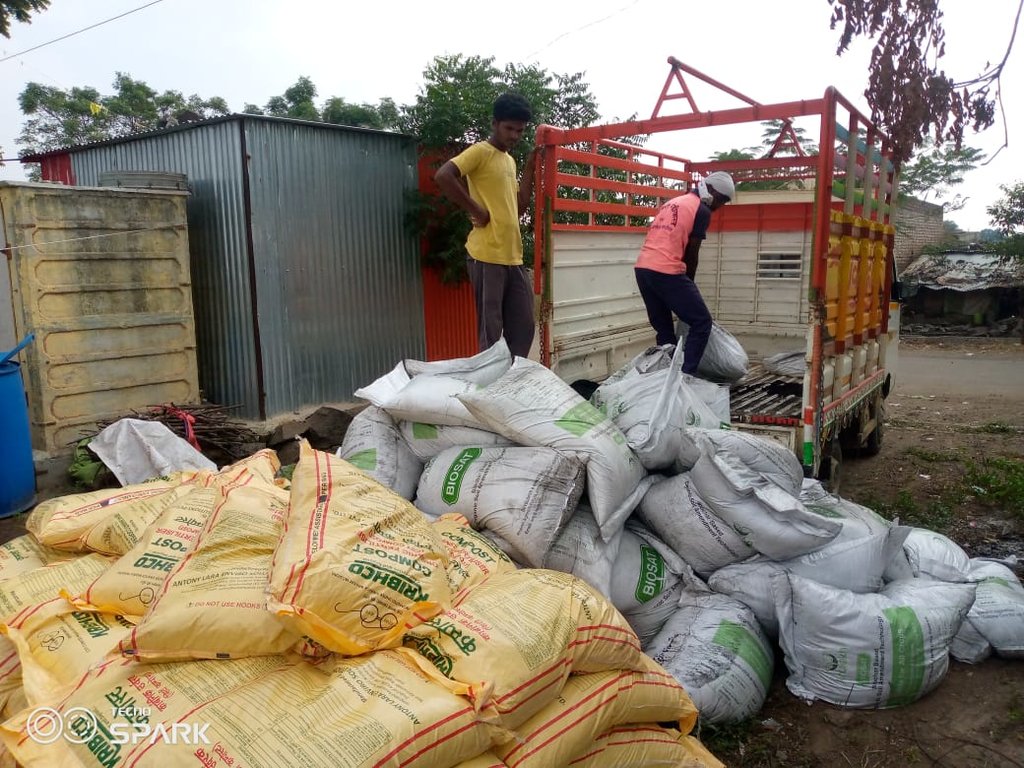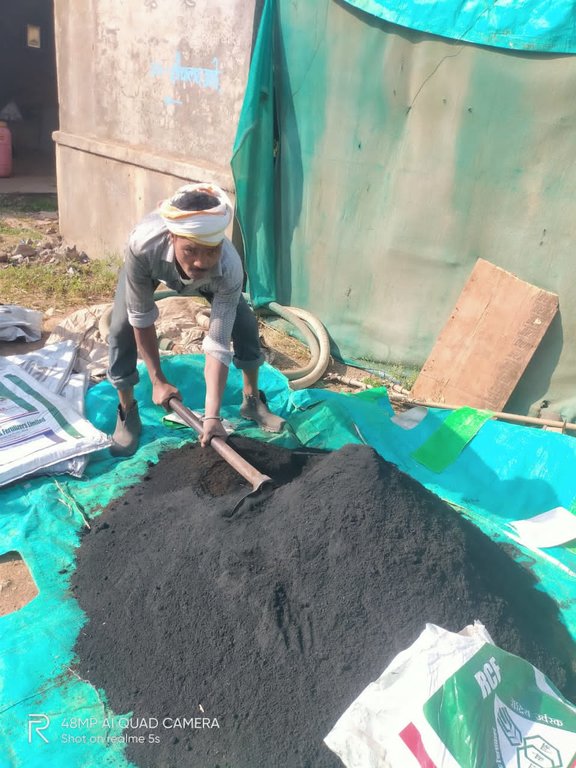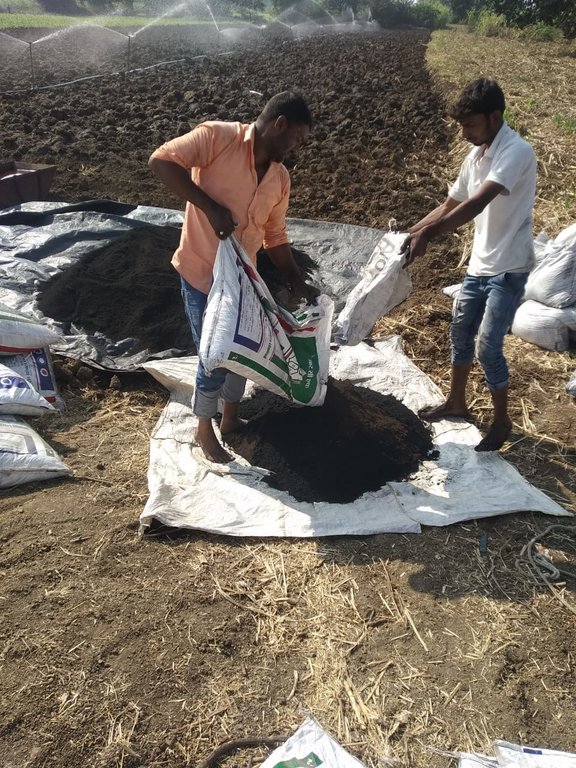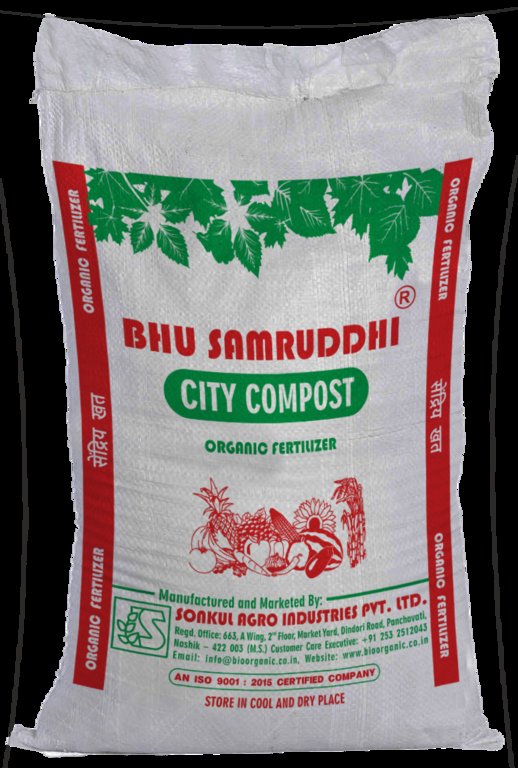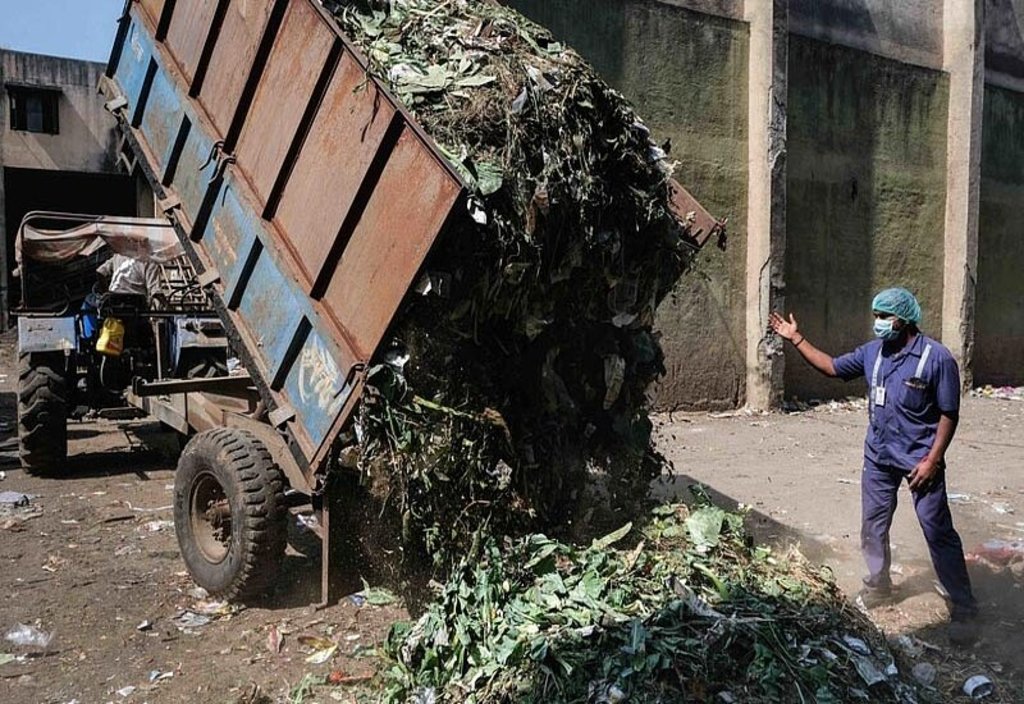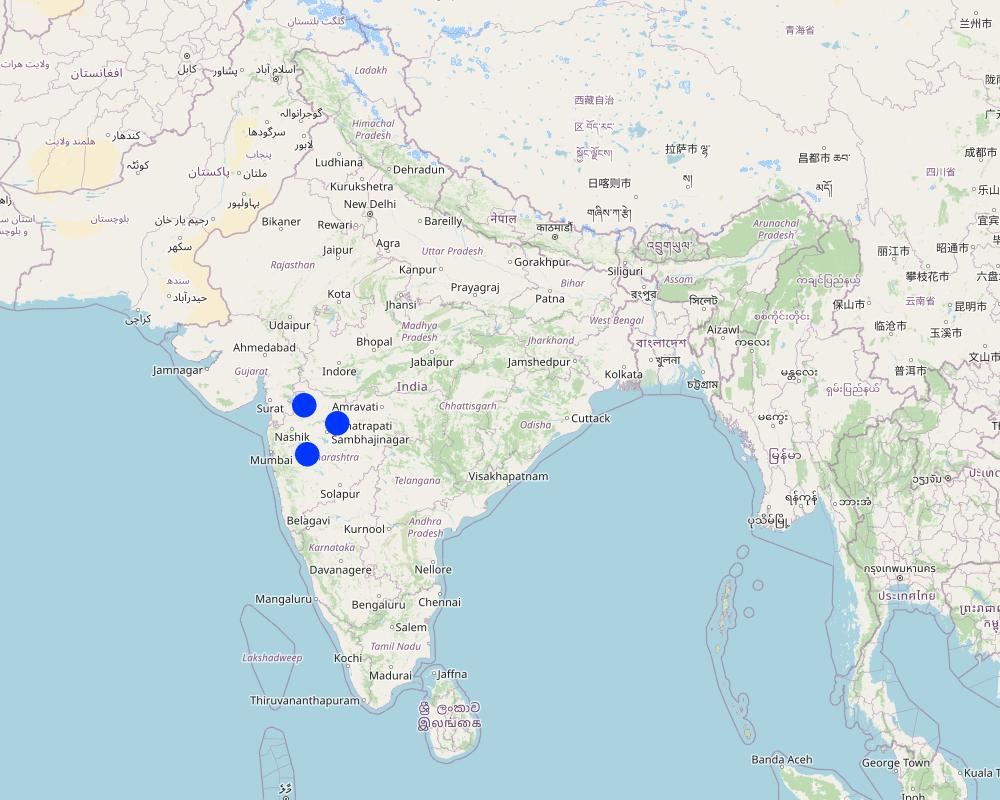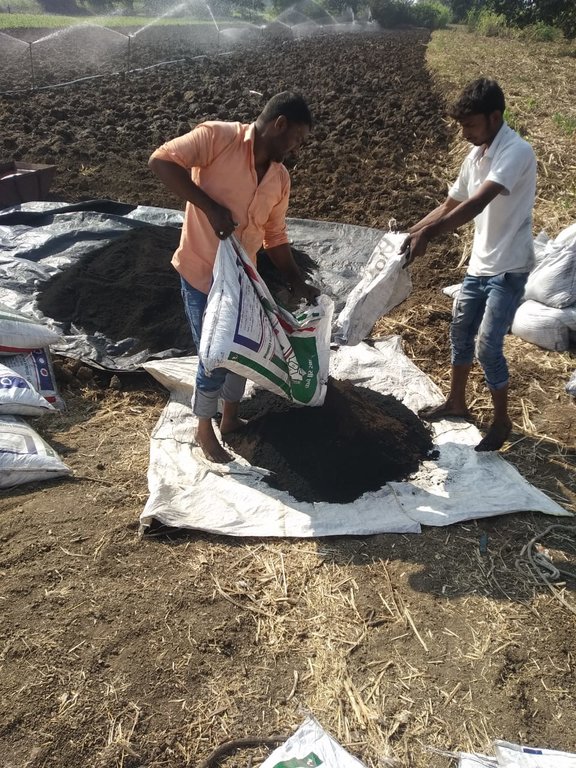City Compost: A Solution For Waste Management And Soil Health Improvement [อินเดีย]
- ผู้สร้างสรรค์:
- การอัพเดท:
- ผู้รวบรวม: Santosh Gupta
- ผู้เรียบเรียง: Noel Templer, Stephanie Katsir
- ผู้ตรวจสอบ: Udo Höggel, Joana Eichenberger
Khachra Khad
technologies_6728 - อินเดีย
ดูส่วนย่อย
ขยายทั้งหมด ย่อทั้งหมด1. ข้อมูลทั่วไป
1.2 รายละเอียดที่ติดต่อได้ของผู้รวบรวมและองค์กรที่เกี่ยวข้องในการประเมินและการจัดเตรียมทำเอกสารของเทคโนโลยี
ชื่อของโครงการซึ่งอำนวยความสะดวกในการทำเอกสารหรือการประเมินเทคโนโลยี (ถ้าเกี่ยวข้อง)
Soil protection and rehabilitation for food security (ProSo(i)l)ชื่อขององค์กรซึ่งอำนวยความสะดวกในการทำเอกสารหรือการประเมินเทคโนโลยี (ถ้าเกี่ยวข้อง)
Deutsche Gesellschaft für Internationale Zusammenarbeit (GIZ) GmbH (GIZ) - เยอรมนีชื่อขององค์กรซึ่งอำนวยความสะดวกในการทำเอกสารหรือการประเมินเทคโนโลยี (ถ้าเกี่ยวข้อง)
Alliance Bioversity and International Center for Tropical Agriculture (Alliance Bioversity-CIAT) - เคนยาชื่อขององค์กรซึ่งอำนวยความสะดวกในการทำเอกสารหรือการประเมินเทคโนโลยี (ถ้าเกี่ยวข้อง)
Ecociate Consultants (Ecociate Consultants) - อินเดีย1.3 เงื่อนไขการใช้ข้อมูลที่ได้บันทึกผ่านทาง WOCAT
ผู้รวบรวมและวิทยากรหลักยอมรับเงื่อนไขเกี่ยวกับการใช้ข้อมูลที่ถูกบันทึกผ่านทาง WOCAT:
ใช่
1.4 การเปิดเผยเรื่องความยั่งยืนของเทคโนโลยีที่ได้อธิบายไว้
เทคโนโลยีที่ได้อธิบายไว้นี้เป็นปัญหาของความเสื่อมโทรมโทรมของที่ดินหรือไม่ จึงไม่ได้รับการยอมรับว่าเป็นเทคโนโลยีเพื่อการจัดการที่ดินอย่างยั่งยืน:
ไม่ใช่
แสดงความคิดเห็น:
The application of city compost improves the soil health
2. การอธิบายลักษณะของเทคโนโลยี SLM
2.1 การอธิบายแบบสั้น ๆ ของเทคโนโลยี
คำจำกัดความของเทคโนโลยี:
The use of city compost is a sustainable solution for addressing the problem of waste management and soil degradation. Under this technology, urban municipal waste is composted and used as organic fertiliser in agriculture. This relieves the cities’ waste management, enhances rural soils and in turn improves farm productivity.
2.2 การอธิบายแบบละเอียดของเทคโนโลยี
คำอธิบาย:
In India, over 377 million people live in almost 8,000 cities or towns. They generate 62 million tons of municipal solid waste annually, according to the country’s government. More than 80% of such solid waste is deposited indiscriminately without treatment at dump yards in an unhygienic manner. In the Indian countryside, the ecological sustainability of agriculture has been at risk due to the excessive use of chemical fertilizers and monoculture since the ‘Green Revolution’ led to the degradation of land.
City compost is one of the solutions to both problems. Waste collected by municipal corporations is processed to make compost. During this process, organic waste is collected in the cities, recycled, processed to compost, and finally used as organic matter by farmers complementing the traditional farmyard manure. In such manner carbon that is contained in the waste is recycled back into the soil thus enhancing agricultural production.
Nashik Municipal Corporation in Nashik town of Maharashtra State in India has set-up a waste processing plant in the town. This plant processes the city’s organic waste into compost through a scientific process. The processed city compost is packed into bags of 50 kg each and these bags are supplied to fertilizer companies and further on to farmers. There are Government subsidies available to farmers for the purchase of compost bags subject to documentary proofs and other conditions.
Under the “Soil Protection and Rehabilitation for Food Security (ProSoil)” project of GIZ, farmers and FPOs (farmer producer organizations) have been supported for the application of city compost in their fields. Supported by the implementing agency WOTR (Watershed Organization Trust) the city compost application in farmer's fields in 3 districts of Maharashtra namely Ahmednagar, Jalna and Dhule has been introduced. Interventions covered more than 3000 farmers and around 1100 Acres of land. The entire intervention is implemented with the help of FPOs, which procured the city compost from ‘The Nashik Waste Management Centre’ and sold the procured material further to the farming communities. This has ensured easy availability to the farmers without incurring undue travel cost. Farmers applied the city waste compost in their farms during the month of May/June (before the onset of monsoon) to different crops.
City compost was applied to different crop combinations such as paddy-chickpea in Dhule District (moderate irrigation facility), greengram-sorghum in Ahmed Nagar District (Rainfed conditions) and soyabean-wheat in Jalna District (irrigated conditions). Farmers have seen the benefits of city compost across all crop combinations and geographies. The application of city compost has been of benefit to farmers in reducing the usage of synthetic fertilizers along with reducing the dependency on farmyard manure as it is getting scarce day by day. Farmers have also realized the improved soil health leading to better productivity of their farms.
The Indian government has also launched several initiatives to promote the use of city compost in agriculture. For example, the National Mission for Sustainable Agriculture provides financial assistance to farmers for the purchase of city compost, and the Fertilizer Control Order allows the use of city compost as a fertilizer. Although developing city waste as compost and its application in the farmer's field is a nascent approach from the India Government and other stakeholders, however looking at the availability of waste, the commitment of the Indian Government through its ‘Clean India Program’ and the vast issue of synthetic fertilizers usage and high subsidy burden, the use of city compost in agriculture has the potential to contribute to sustainable solutions in the area of waste management while improving soil health and reducing the use of synthetic fertilizers in India.
2.3 รูปภาพของเทคโนโลยี
2.4 วีดีโอของเทคโนโลยี
ความคิดเห็น/อธิบายสั้นๆ:
https://www.youtube.com/watch?v=Jms1dp3DABU
2.5 ประเทศภูมิภาค หรือสถานที่ตั้งที่เทคโนโลยีได้นำไปใช้และได้รับการครอบคลุมโดยการประเมินนี้
ประเทศ:
อินเดีย
ภูมิภาค/รัฐ/จังหวัด:
Maharashtra
ข้อมูลจำเพาะเพิ่มเติมของสถานที่ตั้ง :
Ahmednagar, Jalna, Dhule
ระบุการกระจายตัวของเทคโนโลยี:
- ใช้ ณ จุดที่เฉพาะเจาะจงหรือเน้นไปยังบริเวณพื้นที่ขนาดเล็ก
Is/are the technology site(s) located in a permanently protected area?
ไม่ใช่
แสดงความคิดเห็น:
The intervention is implemented with around 1100 farmers across the 3 districts namely Ahmednagar, Jalna and Dhule in the Indian state of Maharashtra
Map
×2.6 วันที่การดำเนินการ
ระบุปีที่ใช้:
2021
2.7 คำแนะนำของเทคโนโลยี
ให้ระบุว่าเทคโนโลยีถูกแนะนำเข้ามาอย่างไร:
- ในช่วงการทดลองหรือการทำวิจัย
- ทางโครงการหรือจากภายนอก
ความคิดเห็น (ประเภทของโครงการ เป็นต้น) :
Developing city compost is a result of research by various agencies. However, the application of the city compost technology is part of the Pro-Soil project of GIZ.
3. การจัดประเภทของเทคโนโลยี SLM
3.1 วัตถุประสงค์หลักของเทคโนโลยี
- ปรับปรุงการผลิตให้ดีขึ้น
- ลด ป้องกัน ฟื้นฟู การเสื่อมโทรมของที่ดิน
- สร้างผลกระทบทางด้านเศรษฐกิจที่เป็นประโยชน์
- Reduce municipal waste
3.2 ประเภทของการใช้ที่ดินในปัจจุบันที่ได้นำเทคโนโลยีไปใช้
Land use mixed within the same land unit:
ไม่ใช่

พื้นที่ปลูกพืช
- การปลูกพืชล้มลุกอายุปีเดียว
Annual cropping - Specify crops:
- cereals - rice (upland)
- cereals - sorghum
- cereals - wheat (winter)
- legumes and pulses - beans
- legumes and pulses - soya
จำนวนของฤดูเพาะปลูกต่อปี:
- 2
ระบุ:
Paddy-Chickpea, Greengram-Sorghum, Soybean-Wheat
Is intercropping practiced?
ใช่
If yes, specify which crops are intercropped:
Maize, Vegetables, Fodder crops
Is crop rotation practiced?
ใช่
ถ้าใช่ ระบุ:
Mostly rotation happens during the winter crops. Chick-pea is replaced with gram or beans are replaced with other vegetables
แสดงความคิดเห็น:
The intervention is mostly applied on cropland.
3.3 Has land use changed due to the implementation of the Technology?
Has land use changed due to the implementation of the Technology?
- No (Continue with question 3.4)
3.4 การใช้น้ำ
การใช้น้ำของที่ดินที่มีการใช้เทคโนโลยีอยู่:
- น้ำฝนร่วมกับการชลประทาน
แสดงความคิดเห็น:
The rainfall pattern varied from location to location and farmer to farmer depending upon the accessibility to canals and availability of resources to lift the ground water. Most farmers in Ahmednagar are rainfed farmers while in Jalna they have some irrigation facilities.
3.5 กลุ่ม SLM ที่ตรงกับเทคโนโลยีนี้
- ระบบหมุนเวียน (การปลูกพืชหมุนเวียน การพักดิน การเกษตรแบบไร่เลื่อนลอย)
- การจัดการความอุดมสมบรูณ์ของดินแบบผสมผสาน
- การจัดการของเสีย / การจัดการน้ำเสีย
3.6 มาตรการ SLM ที่ประกอบกันเป็นเทคโนโลยี

มาตรการจัดการพืช
- A2: อินทรียวัตถุในดิน/ความอุดมสมบูรณ์ในดิน
แสดงความคิดเห็น:
Application of city compost is an agronomic measure as it needs to be applied every year and is closely linked to the agricultural cycle. The application of city compost adds organic matter to the soil and improves the soil fertility.
3.7 รูปแบบหลักของการเสื่อมโทรมของที่ดินที่ได้รับการแก้ไขโดยเทคโนโลยี

การเสื่อมโทรมของดินทางด้านเคมี
- Cn (Fertility decline): ความอุดมสมบูรณ์และปริมาณอินทรียวัตถุในดินถูกทำให้ลดลงไป (ไม่ได้เกิดจากสาเหตุการกัดกร่อน)
แสดงความคิดเห็น:
Application of city compost can significantly reduce the usage of chemical fertilisers in the soil as it can supply the required nutrients to the soil. It is also a relatively cheap option.
3.8 การป้องกัน การลดลง หรือการฟื้นฟูความเสื่อมโทรมของที่ดิน
ระบุเป้าหมายของเทคโนโลยีกับความเสื่อมโทรมของที่ดิน:
- ฟื้นฟูบำบัดที่ดินที่เสื่อมโทรมลงอย่างมาก
4. ข้อมูลจำเพาะด้านเทคนิค กิจกรรมการนำไปปฏิบัติใช้ ปัจจัยนำเข้า และค่าใช้จ่าย
4.1 แบบแปลนทางเทคนิคของเทคโนโลยี
ข้อมูลจำเพาะด้านเทคนิค (แบบแปลนทางเทคนิคของเทคโนโลยี):
An overview of the field where city compost is applied
4.2 ข้อมูลทั่วไปเกี่ยวกับการคำนวณปัจจัยนำเข้าและค่าใช้จ่าย
ให้ระบุว่าค่าใช้จ่ายและปัจจัยนำเข้าได้รับการคำนวณอย่างไร:
- ต่อพื้นที่ที่ใช้เทคโนโลยี
ระบุขนาดและหน่วยพื้นที่:
Hectare
อื่นๆ หรือสกุลเงินประจำชาติ (ระบุ):
INR
If relevant, indicate exchange rate from USD to local currency (e.g. 1 USD = 79.9 Brazilian Real): 1 USD =:
80.0
ระบุค่าเฉลี่ยของค่าจ้างในการจ้างแรงงานต่อวัน:
200
4.3 กิจกรรมเพื่อการจัดตั้ง
แสดงความคิดเห็น:
There are no establishment activities involved in the intervention as farmers are buying the city compost and applying it annually in their fields. The establishment of city compost plant is out of the purview of farmers and their institution.
4.4 ค่าใช้จ่ายของปัจจัยนำเข้าที่จำเป็นสำหรับการจัดตั้ง
แสดงความคิดเห็น:
There is no establishment cost involved in the intervention as farmers are buying the city compost and applying annually in their fields. The establishment of a city compost plant is out of the purview of farmers and their institutions.
4.5 การบำรุงรักษาสภาพหรือกิจกรรมที่เกิดขึ้นเป็นประจำ
| กิจกรรม | ช่วงระยะเวลา/ความถี่ | |
|---|---|---|
| 1. | Purchase of city compost by FPO and transportation to the base location | April/May |
| 2. | Selling of the city compost among the farmers | May |
| 3. | Application of city compost in the field by farmers | May or early June |
| 4. | Mixing of the city compost in soil using the cultivator or rotavator | May/June (Immediately after the application) |
| 5. | Irrigation of the field | Mid June or at the onset of Monsoon (farmers having assured irrigation due with their own sources) |
| 6. | Sowing of the seeds | June or early July |
| 7. | Intercultural operations (Weeding, nutrient management, pest application, crop monitoring) | July-October |
| 8. | Harvesting of the crops | October/November |
แสดงความคิดเห็น:
The timing of these activities may vary a bit based on the crops sown by the farmers or the onset of monsoon rains
4.6 ค่าใช้จ่ายของปัจจัยนำเข้าและกิจกรรมที่เกิดขึ้นเป็นประจำที่ต้องการการบำรุงรักษา (ต่อปี)
| ปัจจัยนำเข้า | หน่วย | ปริมาณ | ค่าใช้จ่ายต่อหน่วย | ค่าใช้จ่ายทั้งหมดต่อปัจจัยนำเข้า | %ของค่าใช้จ่ายที่ก่อให้เกิดขึ้นโดยผู้ใช้ที่ดิน | |
|---|---|---|---|---|---|---|
| แรงงาน | Application of city compost | Person days | 2.0 | 300.0 | 600.0 | 100.0 |
| แรงงาน | Irrigation | Person days | 2.0 | 300.0 | 600.0 | 100.0 |
| อุปกรณ์ | Hired machinery for mixing the city compost in soil | Hours | 2.0 | 900.0 | 1800.0 | 100.0 |
| ปุ๋ยและสารฆ่า/ยับยั้งการเจริญเติบโตของสิ่งมีชีวิต (ไบโอไซด์) | City compost | Ton | 2.5 | 1200.0 | 3000.0 | 100.0 |
| ค่าใช้จ่ายทั้งหมดของการบำรุงรักษาสภาพเทคโนโลยี | 6000.0 | |||||
| Total costs for maintenance of the Technology in USD | 75.0 | |||||
แสดงความคิดเห็น:
The cost towards other operations such as sowing, intercultural operations, pest management and harvesting is not covered here as these costs are not directly associated with the documented intervention.
4.7 ปัจจัยสำคัญที่สุดที่มีผลกระทบต่อค่าใช้จ่าย
ปัจจัยสำคัญที่สุดที่มีผลกระทบต่อค่าใช้จ่ายต่างๆ:
The cost of city compost is available at a subsidised price of INR 1000 per ton incl. transportation. Non-subsidised prices range at INR 3000 per ton plus transportation. Project farmers could get it at subsidised rates. However, the non-availability of required documents may be a hindrance for farmers to avail the subsidised prices.
5. สิ่งแวดล้อมทางธรรมชาติและของมนุษย์
5.1 ภูมิอากาศ
ฝนประจำปี
- < 250 ม.ม.
- 251-500 ม.ม.
- 501-750 ม.ม.
- 751-1,000 ม.ม.
- 1,001-1,500 ม.ม.
- 1,501-2,000 ม.ม.
- 2,001-3,000 ม.ม.
- 3,001-4,000 ม.ม.
- > 4,000 ม.ม.
ระบุปริมาณน้ำฝนเฉลี่ยรายปี (ถ้ารู้) :หน่วย ม.ม.
566.00
ข้อมูลจำเพาะ/ความคิดเห็นเรื่องปริมาณน้ำฝน:
On an average, there are 34 rainy days (i.e. days with rainfall of 2.5 mm or more) in a year in the district. The major rainfall is usually received during months of June to September.
ระบุชื่อของสถานีตรวดวัดอากาศที่ใช้อ้างอิงคือ:
IMD, Pune
เขตภูมิอากาศเกษตร
- กึ่งแห้งแล้ง
The project area comes under the scarcity zone, which is characterised by very low and erratic nature of rainfall, this affects the moisture content in the soil, therefore, this zone is commonly known as a drought-prone area. There is a high scarcity of irrigation water after the month of December. Thus, farmers mostly cultivate crops which can withstand very low water supplies.
5.2 สภาพภูมิประเทศ
ค่าเฉลี่ยความลาดชัน:
- ราบเรียบ (0-2%)
- ลาดที่ไม่ชัน (3-5%)
- ปานกลาง (6-10%)
- เป็นลูกคลื่น (11-15%)
- เป็นเนิน (16-30%)
- ชัน (31-60%)
- ชันมาก (>60%)
ธรณีสัณฐาน:
- ที่ราบสูง/ที่ราบ
- สันเขา
- ไหล่เขา
- ไหล่เนินเขา
- ตีนเนิน
- หุบเขา
ระดับความสูง:
- 0-100 เมตร
- 101-500 เมตร
- 501-1,000 เมตร
- 1,001-1,500 เมตร
- 1,501-2,000 เมตร
- 2,001-2,500 เมตร
- 2,501-3,000 เมตร
- 3,001-4,000 เมตร
- > 4,000 เมตร
ให้ระบุถ้าเทคโนโลยีได้ถูกนำไปใช้:
- ไม่เกี่ยวข้อง
ความคิดเห็นและข้อมูลจำเพาะเพิ่มเติมเรื่องสภาพภูมิประเทศ:
The altitude of district ranges from 500 to 750 meter above sea level. Except a little over 4% area, most part of the district is plain area.
5.3 ดิน
ค่าเฉลี่ยความลึกของดิน:
- ตื้นมาก (0-20 ซ.ม.)
- ตื้น (21-50 ซ.ม.)
- ลึกปานกลาง (51-80 ซ.ม.)
- ลึก (81-120 ซ.ม.)
- ลึกมาก (>120 ซ.ม.)
เนื้อดิน (ดินชั้นบน):
- ปานกลาง (ดินร่วน ทรายแป้ง)
เนื้อดินล่าง (> 20 ซ.ม.ต่ำจากผิวดิน):
- ปานกลาง (ดินร่วน ทรายแป้ง)
อินทรียวัตถุในดิน:
- ต่ำ (<1%)
(ถ้ามี) ให้แนบคำอธิบายเรื่องดินแบบเต็มหรือระบุข้อมูลที่มีอยู่ เช่น ชนิดของดิน ค่า pH ของดินหรือความเป็นกรดของดิน ความสามารถในการแลกเปลี่ยนประจุบวก ไนโตรเจน ความเค็ม เป็นต้น:
Soils vary from reddish brown to dark grey and are commonly grouped as light to medium black soils. In very few places deep black soil is also observed.
5.4 ความเป็นประโยชน์และคุณภาพของน้ำ
ระดับน้ำใต้ดิน:
> 50 เมตร
น้ำไหลบ่าที่ผิวดิน:
ไม่ดีหรือไม่มีเลย
คุณภาพน้ำ (ที่ยังไม่ได้บำบัด):
เป็นน้ำใช้เพื่อการเกษตรเท่านั้น (การชลประทาน)
Water quality refers to:
ground water
ความเค็มของน้ำเป็นปัญหาหรือไม่:
ใช่
ระบุ:
As per the water samples collected by the Central Ground Water Board, 73% samples were reported as high salinity water (EC in the range of 750-2250 qS/cm). Please refer to: (http://cgwb.gov.in/District_Profile/Maharashtra/Ahmadnagar.pdf
กำลังเกิดน้ำท่วมในพื้นที่หรือไม่:
ไม่ใช่
ความคิดเห็นและข้อมูลจำเพาะเพิ่มเติมเรื่องคุณภาพและปริมาณน้ำ:
A large majority of the area is a water scarce area with a dry long spell being a common feature. As indicated above the quality of water is also poor, which makes it even unusable for irrigation. During the last couple of years there has been enormous efforts to develop the surface water harvesting infrastructure in project areas.
5.5 ความหลากหลายทางชีวภาพ
ความหลากหลายทางชนิดพันธุ์:
- ต่ำ
ความหลากหลายของแหล่งที่อยู่:
- ปานกลาง
ความคิดเห็นและข้อมูลจำเพาะเพิ่มเติมของความหลากหลายทางชีวภาพ:
The western hilly part of Ahmednagar District has forests. Teak, Babul, Dhavada, Haldu and Neem are trees found in these forests. Fruit trees like Mango, Tamarind, Amala, Bor are also found in the District.
5.6 ลักษณะของผู้ใช้ที่ดินที่นำเทคโนโลยีไปปฏิบัติใช้
อยู่กับที่หรือเร่ร่อน:
- อยู่กับที่
แนวทางการตลาดของระบบการผลิต:
- mixed (subsistence/ commercial)
รายได้ที่มาจากนอกฟาร์ม:
- 10-50% ของรายได้ทั้งหมด
ระดับของความมั่งคั่งโดยเปรียบเทียบ:
- พอมีพอกิน
เป็นรายบุคคล/ครัวเรือน:
- เป็นรายบุคคล/ครัวเรือน
- สหกรณ์
ระดับของการใช้เครื่องจักรกล:
- การใช้กำลังจากสัตว์
- การใช้เครื่องจักรหรือเครื่องยนต์
เพศ:
- หญิง
- ชาย
อายุของผู้ใช้ที่ดิน:
- ผู้เยาว์
- วัยกลางคน
ระบุลักษณะอื่นๆที่เกี่ยวข้องของผู้ใช้ที่ดิน:
Due to poor rainfall patterns and non-availability of irrigation, most farmers are in a position to cultivate only 1-2 food crops in the year. The prevalence of cash crops is very minimal. Farmers have been grouped into 4 farmer-producer organisations formed under the Pro-Soil Project. All of these groups have a good representation of women farmers.
5.7 Average area of land used by land users applying the Technology
- < 0.5 เฮกตาร์
- 0.5-1 เฮกตาร์
- 1-2 เฮกตาร์
- 2-5 เฮกตาร์
- 5-15 เฮกตาร์
- 15-50 เฮกตาร์
- 50-100 เฮกตาร์
- 100-500 เฮกตาร์
- 500-1,000 เฮกตาร์
- 1,000-10,000 เฮกตาร์
- >10,000 เฮกตาร์
พิจารณาว่าเป็นขนาดเล็ก กลาง หรือขนาดใหญ่ (ซึ่งอ้างอิงถึงบริบทระดับท้องถิ่น):
- ขนาดเล็ก
แสดงความคิดเห็น:
A large majority of the land users are small and marginal farmers
5.8 กรรมสิทธิ์ในที่ดิน สิทธิในการใช้ที่ดินและสิทธิในการใช้น้ำ
กรรมสิทธิ์ในที่ดิน:
- รายบุคคล ได้รับสิทธิครอบครอง
สิทธิในการใช้ที่ดิน:
- รายบุคคล
สิทธิในการใช้น้ำ:
- เกี่ยวกับชุมชน (ถูกจัดระเบียบ)
- รายบุคคล
Are land use rights based on a traditional legal system?
ใช่
แสดงความคิดเห็น:
All the project farmers have land titles either in their name or their family members' name. These land rights are transferred among the family members as part of the Indian land transfer systems.
5.9 การเข้าถึงบริการและโครงสร้างพื้นฐาน
สุขภาพ:
- จน
- ปานกลาง
- ดี
การศึกษา:
- จน
- ปานกลาง
- ดี
ความช่วยเหลือทางด้านเทคนิค:
- จน
- ปานกลาง
- ดี
การจ้างงาน (เช่น ภายนอกฟาร์ม):
- จน
- ปานกลาง
- ดี
ตลาด:
- จน
- ปานกลาง
- ดี
พลังงาน:
- จน
- ปานกลาง
- ดี
ถนนและการขนส่ง:
- จน
- ปานกลาง
- ดี
น้ำดื่มและการสุขาภิบาล:
- จน
- ปานกลาง
- ดี
บริการด้านการเงิน:
- จน
- ปานกลาง
- ดี
แสดงความคิดเห็น:
In terms of infrastructure and services, Ahmednagar is well-connected with most services. However, still there is a scope to improve these further to make farmers' life better.
6. ผลกระทบและสรุปคำบอกกล่าว
6.1 ผลกระทบในพื้นที่ดำเนินการ (On-site) จากการใช้เทคโนโลยี
ผลกระทบทางด้านเศรษฐกิจและสังคม
การผลิต
การผลิตพืชผล
จำนวนก่อน SLM:
1800 kg
หลังจาก SLM:
2300 kg
แสดงความคิดเห็น/ระบุ:
Based on the assessment of the project implementing agency. However, crop production increases are not only to city compost. There were other technologies, which have also contributed to improving productivity. There is no assessment for the stand-alone compost intervention.
คุณภาพพืชผล
แสดงความคิดเห็น/ระบุ:
Reduced usage of synthetic fertilisers made the grains and pluses safer for consumption
รายได้และค่าใช้จ่าย
ค่าใช่จ่ายของปัจจัยการผลิตทางการเกษตร
จำนวนก่อน SLM:
3600
หลังจาก SLM:
3200
แสดงความคิดเห็น/ระบุ:
Reduced cost towards synthetic fertilisers
รายได้จากฟาร์ม
แสดงความคิดเห็น/ระบุ:
Improved income due to improved productivity. Quantifiable numbers are however, not available.
ผลกระทบด้านสังคมวัฒนธรรมอื่น ๆ
ความมั่นคงด้านอาหาร / พึ่งตนเองได้
สถาบันของชุมชน
แสดงความคิดเห็น/ระบุ:
Training and handholding support was provided from the project for procurement of city compost, governance and other areas.
ผลกระทบด้านนิเวศวิทยา
ดิน
ความชื้นในดิน
อินทรียวัตถุในดิน/ต่ำกว่าดินชั้น C
แสดงความคิดเห็น/ระบุ:
Reported by the implementing agency
Specify assessment of on-site impacts (measurements):
Overall, city compost has replaced the usage of synthetic fertilisers
6.2 ผลกระทบนอกพื้นที่ดำเนินการ (Off-site) จากการใช้เทคโนโลยี
Specify assessment of off-site impacts (measurements):
The off-site impact can be contributed in terms of the reduction of waste at the waste processing site. However, this may not directly be linked to farmers' application of city compost in their farms.
6.3 การเผชิญและความตอบสนองของเทคโนโลยีต่อการเปลี่ยนแปลงสภาพภูมิอากาศที่ค่อยเป็นค่อยไป และสภาพรุนแรงของภูมิอากาศ / ภัยพิบัติ (ที่รับรู้ได้โดยผู้ใช้ที่ดิน)
การเปลี่ยนแปลงสภาพภูมิอากาศที่ค่อยเป็นค่อยไป
การเปลี่ยนแปลงสภาพภูมิอากาศที่ค่อยเป็นค่อยไป
| ฤดู | increase or decrease | เทคโนโลยีมีวิธีการรับมืออย่างไร | |
|---|---|---|---|
| อุณหภูมิประจำปี | เพิ่มขึ้น | ไม่ทราบ | |
| อุณหภูมิตามฤดูกาล | ฤดูหนาว | เพิ่มขึ้น | ไม่ทราบ |
| ฝนประจำปี | ลดลง | ปานกลาง |
สภาพรุนแรงของภูมิอากาศ (ภัยพิบัติ)
ภัยพิบัติจากสภาพภูมิอากาศ
| เทคโนโลยีมีวิธีการรับมืออย่างไร | |
|---|---|
| คลื่นความร้อน | ไม่ทราบ |
| คลื่นความหนาว | ไม่ทราบ |
| สภาพอากาศฤดูหนาวที่รุนแรง | ไม่ทราบ |
| ภัยจากฝนแล้ง | ปานกลาง |
แสดงความคิดเห็น:
The technology being very new its long-term impact of it is not well documented or assessed. However, compost in general is good for maintaining soil moisture and thus suited to the conditions of long dry spells.
6.4 การวิเคราะห์ค่าใช้จ่ายและผลประโยชน์ที่ได้รับ
ผลประโยชน์ที่ได้รับเปรียบเทียบกับค่าใช้จ่ายในการบำรุงรักษาหรือต้นทุนที่เกิดขึ้นซ้ำอีก เป็นอย่างไร (จากมุมมองของผู้ใช้ที่ดิน)
ผลตอบแทนระยะสั้น:
ด้านบวกเล็กน้อย
ผลตอบแทนระยะยาว:
ด้านบวกอย่างมาก
แสดงความคิดเห็น:
City compost does not have any establishment cost at the farmers' level. In terms of maintenance cost, it is beneficial to farmers both in short term and long run.
6.5 การปรับตัวของเทคโนโลยี
- 1-10%
ถ้ามีข้อมูลให้บอกปริมาณด้วย (จำนวนของครัวเรือนหรือครอบคลุมพื้นที่):
1100
Of all those who have adopted the Technology, how many did so spontaneously, i.e. without receiving any material incentives/ payments?
- 91-100%
แสดงความคิดเห็น:
Most of the farmers have paid the money for buying the city compost from FPOs. Support from the project has been towards creating awareness, setting up the demonstration plots and handholding of FPOs.
6.6 การปรับตัว
เทคโนโลยีได้รับการปรับเปลี่ยนเมื่อเร็วๆนี้ เพื่อให้ปรับตัวเข้ากับสภาพที่กำลังเปลี่ยนแปลงหรือไม่:
ไม่ใช่
6.7 จุดแข็ง / ข้อได้เปรียบ / โอกาสของเทคโนโลยี
| จุดแข็ง / ข้อได้เปรียบ / โอกาสในทัศนคติของผู้ใช้ที่ดิน |
|---|
| A good replacement for farmyard manure (dung) as its availability is a challenge due to reduction in numbers of livestock |
| Improved productivity of major crops |
| Farmers have observed improvement in soil moisture and soil texture which indicates a better soil health |
| จุดแข็ง / ข้อได้เปรียบ / โอกาสในทัศนคติของผู้รวบรวมหรือวิทยากรหลัก |
|---|
| This is an excellent mechanism to promote the waste management and address this long-standing problem of the country |
| An economically cheaper option to meet the composting needs of farmers thus promoting the natural farming |
| A good business line for FPOs as city compost is generally not available in the market |
| In the longer run, regular application of compost can improve the soil organic carbon |
6.8 จุดอ่อน / ข้อเสียเปรียบ / ความเสี่ยงของเทคโนโลยีและวิธีการแก้ไข
| จุดอ่อน / ข้อเสียเปรียบ / ความเสี่ยงในทัศนคติของผู้ใช้ที่ดิน | มีวิธีการแก้ไขได้อย่างไร |
|---|---|
| Currently available in Nashik city only which is 150 km from the project area | Collective procurement by FPO and selling it to its members |
| Prices of city compost are very high at the non-subsidised prices | Farmers can keep their documents updated to get the subsidised compost. Also put up an application to concerned authorities for continuation of subsidy. |
| จุดอ่อน / ข้อเสียเปรียบ / ความเสี่ยงในทัศนคติของผู้รวบรวมหรือวิทยากรหลัก | มีวิธีการแก้ไขได้อย่างไร |
|---|---|
| Regular supply from the waste processing plants. Many such plants do not operate regularly due to internal and external reasons. | FPOs can undertake some longterm contracts with the company. Also in the long run they can set-up small plants for local-level composting. |
7. การอ้างอิงและการเชื่อมต่อ
7.1 วิธีการและแหล่งข้อมูล
- ไปเยี่ยมชมภาคสนาม การสำรวจพื้นที่ภาคสนาม
10
- การสัมภาษณ์กับผู้ใช้ที่ดิน
4
- การสัมภาษณ์ผู้เชี่ยวชาญด้าน SLM หรือผู้ชำนาญ
2
- การเก็บรวบรวมมาจากรายงานและเอกสารที่มีอยู่
3
วันที่เก็บรวบรวมข้อมูล(ภาคสนาม) :
06/04/2023
7.3 Links to relevant online information
ชื่อเรื่องหรือคำอธิบาย:
City compost in India – from waste to healthy soil
URL:
https://www.rural21.com/english/covid-19-dossier/detail/article/city-compost-in-india-from-waste-to-healthy-soil.html
ลิงก์และโมดูล
ขยายทั้งหมด ย่อทั้งหมดลิงก์
ไม่มีลิงก์
โมดูล
ไม่มีโมดูล


